EXCLUSIVE ARTICLE |
||
|
||
EXCLUSIVE ARTICLE |
||
|
||
|
|||||||||||||||||||||||||||||||||||||||||||||||||||||||||||||||||||||||||||||||||||||||||||||||||||||||||||||||||||||||||||||||||||||||||||||||||
|
Throughout the Sixties and into the early Seventies the release of each new James Bond film was a guaranteed money maker for EON Productions and distributor United Artists. Re-issues and double-bills kept the money rolling in before the premiere of the next instalment in the series. The growth in television ownership in the United States in the mid-1950s had prompted film-makers to come up with ever more outlandish methods of getting audiences back into movie theatres. Widescreen, 3-D, stereophonic sound and ‘Roadshow’ releases all tried to present things that television could not. The growing youth culture ushered in more films aimed at a younger audience, but the decline in cinema attendance continued until it reached an all-time low in 1970. |
|||||||||||||||||||||||||||||||||||||||||||||||||||||||||||||||||||||||||||||||||||||||||||||||||||||||||||||||||||||||||||||||||||||||||||||||||
|
|||||||||||||||||||||||||||||||||||||||||||||||||||||||||||||||||||||||||||||||||||||||||||||||||||||||||||||||||||||||||||||||||||||||||||||||||
|
Eventually film-makers had to concede that although television had a hold over the majority of the nation, it was still a secondary market where money was to be made. As early as September 1966 Goldfinger and Thunderball had each attracted bids of $3.5-million for a single television showing, or $7-million for one showing of both! In June 1967 United Artists offered the first five films in the series (and the then unmade On Her Majesty's Secret Service) to US TV stations for $30-million. The proposed deal would allow two films to be released each year over a three-year period; each film could be shown twice and after the deal expired the rights would revert to the owners. The news made the front page headline of the industry trade paper The Hollywood Reporter, and although there was interest at this stage, the record-setting price of $5-million per film proved too expensive at that time. |
|||||||||||||||||||||||||||||||||||||||||||||||||||||||||||||||||||||||||||||||||||||||||||||||||||||||||||||||||||||||||||||||||||||||||||||||||
 |
|||||||||||||||||||||||||||||||||||||||||||||||||||||||||||||||||||||||||||||||||||||||||||||||||||||||||||||||||||||||||||||||||||||||||||||||||
|
United Artists eventually signed a deal with US Television network ABC giving them the rights to screen the first seven films in the series for $2.5-million each. The timing of the sale to US television was clearly a purely financial decision, as it came during the biggest upheaval in EON Productions decade-long history. With the box-office disappointment of On Her Majesty's Secret Service (1969) compared with its predecessors, and the one-off return of Sean Connery in Diamonds Are Forever (1971), EON and United Artists needed an injection of income as they embarked on the production of Live And Let Die. With the introduction of another new James Bond, the filmmakers could hardly predict it would be a guaranteed financial success. As it turned out Roger Moore's debut was a huge international box-office hit when released in June 1973, and the success of the series was assured for the foreseeable future. In May 1972 United Artists also re-released the first three James Bond films starring Sean Connery on a triple-bill advertised as ‘Spend A Night With James Bond!’. This programme was seen across the USA in cinemas and drive-ins until the end of August 1972. |
|||||||||||||||||||||||||||||||||||||||||||||||||||||||||||||||||||||||||||||||||||||||||||||||||||||||||||||||||||||||||||||||||||||||||||||||||
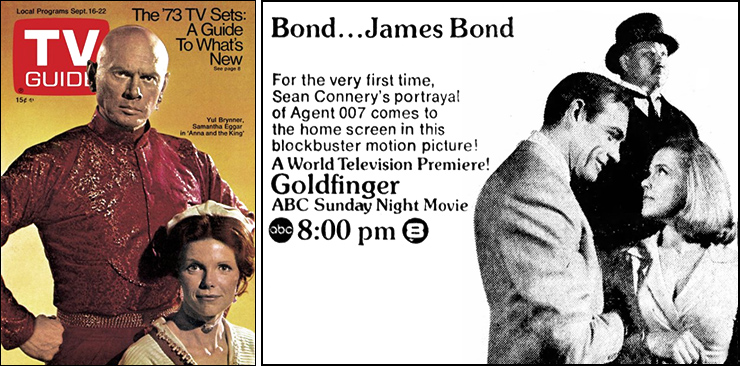 |
|||||||||||||||||||||||||||||||||||||||||||||||||||||||||||||||||||||||||||||||||||||||||||||||||||||||||||||||||||||||||||||||||||||||||||||||||
|
Goldfinger had its world television premiere on September 17, 1972, as the debut film in a new season of ABC's ‘Sunday Night Movie’ strand. The ABC network made edits to the film for violence and sexual content, but also trimmed dialogue in the scene where Bond is trying to dissuade Goldfinger from using a nerve gas on Fort Knox, saying it'll kill 60,000 innocent people. Goldfinger replies “So What? American motorists kill that many people every two years” - that line was cut because the sponsor of the ‘Sunday Night Movie’ was American car manufacturer Chevrolet! |
|||||||||||||||||||||||||||||||||||||||||||||||||||||||||||||||||||||||||||||||||||||||||||||||||||||||||||||||||||||||||||||||||||||||||||||||||
 |
|||||||||||||||||||||||||||||||||||||||||||||||||||||||||||||||||||||||||||||||||||||||||||||||||||||||||||||||||||||||||||||||||||||||||||||||||
|
Unusually none of the James Bond film premieres ever made the cover of the popular weekly American television listings magazine TV Guide. In the week that Goldfinger had its US TV premiere, the cover was devoted to Anna and the King - a small screen non-musical adaptation of the 1951 Rodgers and Hammerstein production The King and I. Although Anna and the King starred Yul Brynner, reprising his Oscar-winning role from the 1956 big-screen musical adaptation, the television version did not prove successful and was cancelled mid-season after 13 episodes. Anna and the King debuted on the CBS network on Sunday September 17, 1972, at the same time as Goldfinger, and opposite the Oscar-winning drama film In The Heat Of the Night (1967) also receiving its US television premiere on the NBC network. |
|||||||||||||||||||||||||||||||||||||||||||||||||||||||||||||||||||||||||||||||||||||||||||||||||||||||||||||||||||||||||||||||||||||||||||||||||
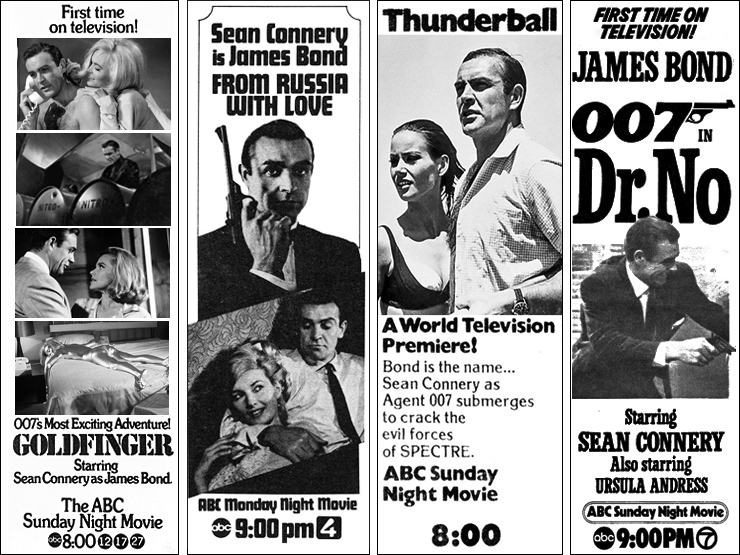 |
|||||||||||||||||||||||||||||||||||||||||||||||||||||||||||||||||||||||||||||||||||||||||||||||||||||||||||||||||||||||||||||||||||||||||||||||||
|
The US television premieres of the James Bond films were heavily advertised on ABC ahead of their broadcast, and in US newspapers often accompanied by stills from different films in the series. In the case of Dr. No, some advertising used a still of Sean Connery despatching Rosa Klebb in From Russia With Love (1963), but with a revolver in his hand in place of the chair seen in the film. |
|||||||||||||||||||||||||||||||||||||||||||||||||||||||||||||||||||||||||||||||||||||||||||||||||||||||||||||||||||||||||||||||||||||||||||||||||
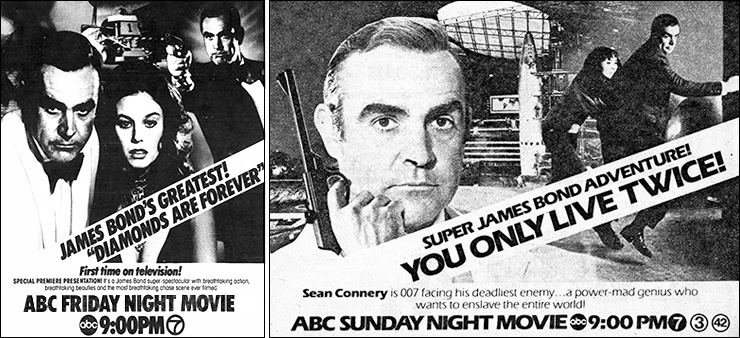 |
|||||||||||||||||||||||||||||||||||||||||||||||||||||||||||||||||||||||||||||||||||||||||||||||||||||||||||||||||||||||||||||||||||||||||||||||||
|
The Bond films were hugely successful on US television (although often heavily censored), and introduced a new audience to 007 throughout the 1970s and 1980s. ABC continued to premiere the films (this time in chronological order) from Live And Let Die which debuted on Sunday, October 31, 1976 until The Living Daylights on Sunday, April 15, 1990. ABC then lost the television rights to premiere the James Bond films which then debuted on the FOX Network. |
|||||||||||||||||||||||||||||||||||||||||||||||||||||||||||||||||||||||||||||||||||||||||||||||||||||||||||||||||||||||||||||||||||||||||||||||||
|
|||||||||||||||||||||||||||||||||||||||||||||||||||||||||||||||||||||||||||||||||||||||||||||||||||||||||||||||||||||||||||||||||||||||||||||||||
|
|||||||||||||||||||||||||||||||||||||||||||||||||||||||||||||||||||||||||||||||||||||||||||||||||||||||||||||||||||||||||||||||||||||||||||||||||
 |
|||||||||||||||||||||||||||||||||||||||||||||||||||||||||||||||||||||||||||||||||||||||||||||||||||||||||||||||||||||||||||||||||||||||||||||||||
|
The 1960s James Bond films had been hugely profitable when first released in the UK with hardly a month going by when one or more was not screening somewhere in the country. The films were re-released individually and revived on double-bills with earlier entries in the series, reaching a peak just before the release of Live And Let Die in 1973. Although the Sean Connery films were still being shown around the country it became increasingly harder to see them once Roger Moore was established in the role of James Bond. |
|||||||||||||||||||||||||||||||||||||||||||||||||||||||||||||||||||||||||||||||||||||||||||||||||||||||||||||||||||||||||||||||||||||||||||||||||
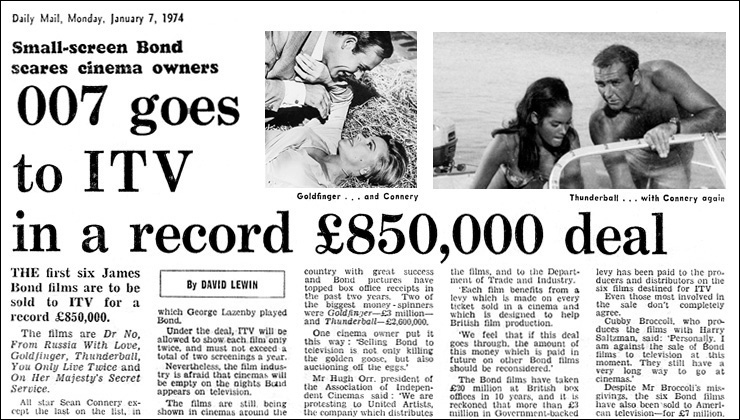 |
|||||||||||||||||||||||||||||||||||||||||||||||||||||||||||||||||||||||||||||||||||||||||||||||||||||||||||||||||||||||||||||||||||||||||||||||||
|
The Battle for Bond on
the small screen |
|||||||||||||||||||||||||||||||||||||||||||||||||||||||||||||||||||||||||||||||||||||||||||||||||||||||||||||||||||||||||||||||||||||||||||||||||
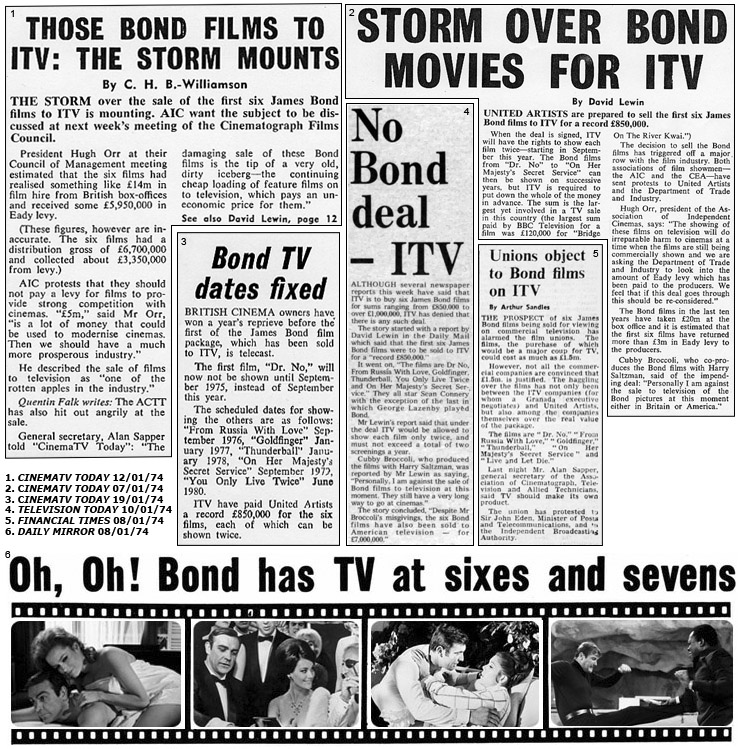 |
|||||||||||||||||||||||||||||||||||||||||||||||||||||||||||||||||||||||||||||||||||||||||||||||||||||||||||||||||||||||||||||||||||||||||||||||||
|
Hugh Orr, president of the Association of Independent Cinemas said: “We are protesting to United Artists, the company which distributes the films, and to the Department of Trade and Industry”. Even James Bond producer Albert R. Broccoli was not convinced by the deal and responded with: “Personally, I am against the sale of Bond films to television at this moment. They still have a very long way to go at the cinemas”. Despite Broccoli's misgivings, the six Bond films had also been sold to American television for £7-million. On January 8, 1974, the Daily Mirror reported that the news had also angered trade unions, and Alan Sapper (general secretary of the Association of Cinematograph, Television and Allied Technicians) claimed that the fee [reported as £1.5-million] was far too low for films that would get two TV showings, and small cinemas would be hit because the films would lose any cinematic value. Protests were made to the Minister of Posts and Telecommunications, and the Independent Broadcasting Authority. The Daily Mirror incorrectly stated that Live And Let Die was part of the deal instead of You Only Live Twice, which explains the inclusion of a still from the film in their report [pictured above]. ITV's response to the news was: “This is all a bit premature”. Two days later in the industry trade paper The Stage and Television Today, their front-page claimed that although several reports had appeared that week stating that ITV was to buy six James Bond films for sums ranging from £850,000 to over £1,000,000, ITV has denied that there is any such deal. |
|||||||||||||||||||||||||||||||||||||||||||||||||||||||||||||||||||||||||||||||||||||||||||||||||||||||||||||||||||||||||||||||||||||||||||||||||
|
|||||||||||||||||||||||||||||||||||||||||||||||||||||||||||||||||||||||||||||||||||||||||||||||||||||||||||||||||||||||||||||||||||||||||||||||||
|
Dr. No premiered on British television at 8.00pm on Tuesday October 28, 1975, and was networked in all ITV regions except Northern Ireland, which showed Cat On A Hot Tin Roof (1958) starring Elizabeth Taylor and Paul Newman in its place. The Ulster TV franchise refused to comment why Dr. No was not scheduled. A spokesman for the Independent Television Authority commented that is was up to individual companies to decide whether or not to show specific films. Ulster television was also the only ITV region that chose not to screen the acclaimed American film Bob and Carol and Ted and Alice (1969) a few weeks earlier. Dr. No was not broadcast in Northern Ireland until Sunday December 28, 1975, marking the first time a James Bond film was shown independently by one of the ITV franchise holders. From Russia With Love then had its ITV premiere on May 2, 1976, followed by Goldfinger (November 3, 1976), Thunderball (ITV Network February 26, 1977 - Harlech, Channel and Westward Television February 27, 1977), You Only Live Twice (November 20, 1977), and On Her Majesty’s Secret Service on September 4, 1978. The first four films of the series all made the front cover of TVTimes - a weekly listings magazine, which in those days only gave details of programmes shown on the ITV network; BBC programmes were listed in Radio Times. |
|||||||||||||||||||||||||||||||||||||||||||||||||||||||||||||||||||||||||||||||||||||||||||||||||||||||||||||||||||||||||||||||||||||||||||||||||
|
The British television premiere of Dr. No was a big coup for ITV and the event featured in three consecutive issues of TVTimes beginning the week before the broadcast, accompanied by a lengthy article by British writer, author and critic Kenneth Passingham (who would later publish a biography of Sean Connery in 1983). The first instalment included a colourful double-page montage [pictured above] by illustrator Mike Francis of author Ian Fleming and the four actors who had played James Bond [including David Niven in Casino Royale (1967)] up to that point. The May 1-7, 1976 edition of TVTimes also featured a cover illustration by Mike Francis depicting the main characters in From Russia With Love, and a page 5 feature on the gadgets by the same artist. The February 26-March 4, 1977 edition advertising the UK TV premiere of Thunderball used a photo of Sean Connery from Diamonds Are Forever. |
|||||||||||||||||||||||||||||||||||||||||||||||||||||||||||||||||||||||||||||||||||||||||||||||||||||||||||||||||||||||||||||||||||||||||||||||||
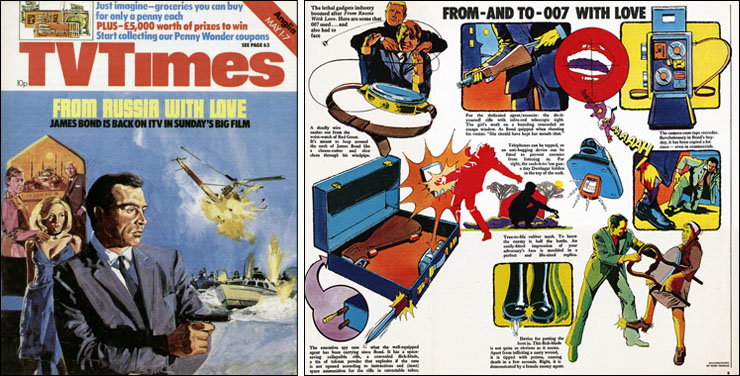 |
|||||||||||||||||||||||||||||||||||||||||||||||||||||||||||||||||||||||||||||||||||||||||||||||||||||||||||||||||||||||||||||||||||||||||||||||||
|
The ITV premieres of You Only Live Twice and On Her Majesty's Secret Service did not make the front of TVTimes, but the 1978 Christmas Day premiere of Diamonds Are Forever was promoted with a cover featuring popular comedy double-act Morecambe & Wise posing with a life-size still of Sean Connery. The TV listings magazine was issued in two versions that Christmas due to print union industrial action limiting the availability in some regions. The Christmas double-issue was released as a full-colour edition featuring listings for all ITV programmes and regional variations from December 22, 1978 - January 5, 1979; and a half-price black & white ‘Emergency Supplement’ of just 24-pages [pictured further down the page in TVTimes listings montage] with listings from December 23, 1978 - January 5, 1979, but not region specific. However, the screening of Sean Connery's final official James Bond film was not a TV ratings winner on its first broadcast. |
|||||||||||||||||||||||||||||||||||||||||||||||||||||||||||||||||||||||||||||||||||||||||||||||||||||||||||||||||||||||||||||||||||||||||||||||||
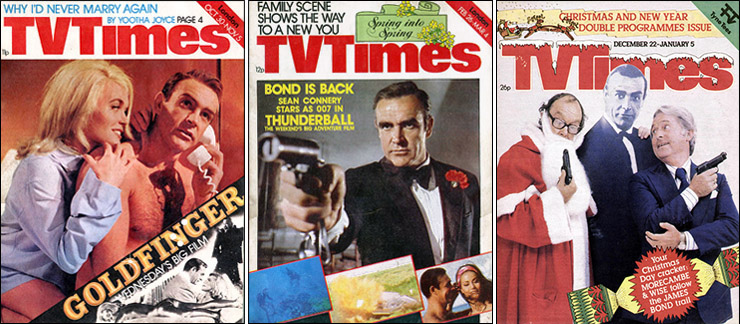 |
|||||||||||||||||||||||||||||||||||||||||||||||||||||||||||||||||||||||||||||||||||||||||||||||||||||||||||||||||||||||||||||||||||||||||||||||||
|
The screenings of the early films on ITV were also promoted heavily on the cover and featured inside Look-In, a weekly magazine which was essentially a junior version of TVTimes aimed mainly at a younger audience. Starting with the first screening of Dr. No in October 1975, the magazine often featured painted covers by renowned Italian poster artist Arnaldo Putzu (1927-2012). Look-In ran from 1971-1994, and throughout the 1970s also featured painted covers by Putzu promoting each new Roger Moore James Bond film when they were first released. |
|||||||||||||||||||||||||||||||||||||||||||||||||||||||||||||||||||||||||||||||||||||||||||||||||||||||||||||||||||||||||||||||||||||||||||||||||
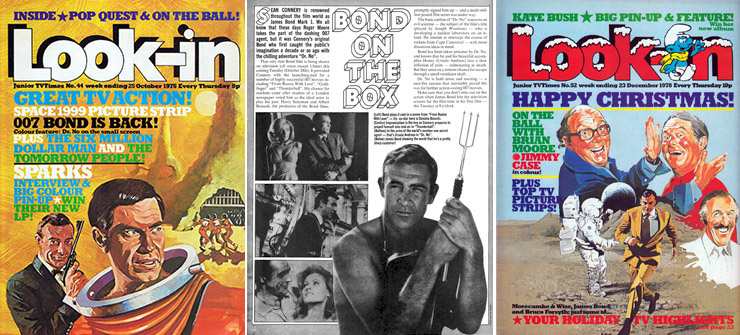 |
|||||||||||||||||||||||||||||||||||||||||||||||||||||||||||||||||||||||||||||||||||||||||||||||||||||||||||||||||||||||||||||||||||||||||||||||||
|
In 1976, encouraged by the huge success of the screening of the first two James Bond films, ITV purchased the rights to show Diamonds Are Forever, Live And Let Die and The Man With The Golden Gun for a sum reported to be more than half-a-million pounds. These films were not part of the original deal and subsequently premiered on ITV in their correct order - with Diamonds Are Forever the big film for Christmas Day 1978; Live And Let Die on January 20, 1980, and The Man With The Golden Gun on Christmas Day 1980. Live And Let Die still holds the record as the most watched film on UK television with a staggering 23.5-million viewers, closely followed by The Spy Who Loved Me (shown March 28, 1982) which had 22.9-million viewers. Diamonds Are Forever also attracted an audience of 22.15-million viewers for its second showing on March 15, 1981. |
|||||||||||||||||||||||||||||||||||||||||||||||||||||||||||||||||||||||||||||||||||||||||||||||||||||||||||||||||||||||||||||||||||||||||||||||||
|
|||||||||||||||||||||||||||||||||||||||||||||||||||||||||||||||||||||||||||||||||||||||||||||||||||||||||||||||||||||||||||||||||||||||||||||||||
|
The screenings of the James Bond films on ITV were always big news and advertisers were keen capitalise on the huge audiences they commanded in the days when there were only a handful of TV channels in the UK. London Weekend Television (ITV franchise holder for London and the Home Counties) often used the screenings of James Bond films to poke fun at the establishment during the 1980s and tied in the screenings with topical news stories of the day. Moles in the secret service and gay spy revelations were cleverly disguised as advertisements for the screening of the Bond film. Huge posters were displayed in the London Underground and on billboards across the city during the week the film was shown. |
|||||||||||||||||||||||||||||||||||||||||||||||||||||||||||||||||||||||||||||||||||||||||||||||||||||||||||||||||||||||||||||||||||||||||||||||||
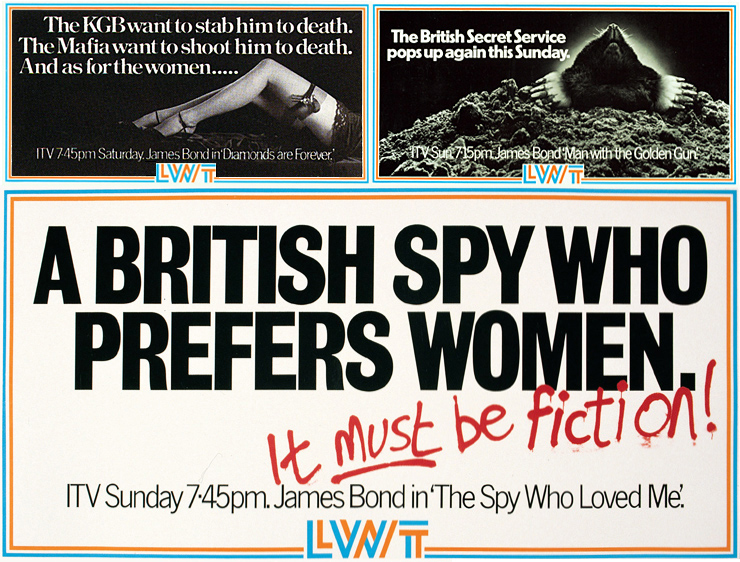 |
|||||||||||||||||||||||||||||||||||||||||||||||||||||||||||||||||||||||||||||||||||||||||||||||||||||||||||||||||||||||||||||||||||||||||||||||||
|
ITV has retained the rights to screen the Bond films on UK terrestrial television since 1975, although other cable and satellite channels have also shown the series in the intervening years. In 2012 BSkyB signed an exclusive deal with MGM allowing the films to be shown on their premium subscription services, on a new channel branded ‘Sky Movies 007’. After the BSkyB deal expired ITV re-acquired the television rights and has retained them ever since. With the exception of Casino Royale (1967) which had its UK TV premiere on BBC1 on Boxing Day evening 1973, and Never Say Never Again which the BBC screened on New Year's Day 1996 (and again on Boxing Day 1996), the only other Bond film to be shown by the BBC is From Russia With Love. BBC2 screened the second James Bond film on Sunday July 29, 2007, as part of a season of films celebrating the Summer of British Film. The season was complemented by a major new seven-part documentary series British Film Forever, and the re-release of selected British films in UK cinemas including the 1964 James Bond classic Goldfinger. The version of From Russia With Love screened by the BBC was the Lowry Digital Images restoration, which was also then available on DVD in the UK as part of the two-disc Ultimate Edition series. Unlike the majority of ITV screenings of the films, the BBC broadcast was uncut, and in the correct aspect ratio. The ITV premieres of more recent films in the series have failed to live up to the record-breaking audience figures the series commanded in the 1970s/80s. With the window between a theatrical release and home entertainment edition narrowing each year, most people have seen the films DVD or blu-ray already, so it is not surprising that the most recent ITV premiere of No Time To Die on New Year's Day 2023 only managed to pull in only 2.5-million viewers. With the sheer number of channels and choice available nowadays, it is impossible for any programme to achieve the kind of viewing figures attracted by the Bond films when they first screened on ITV. |
|||||||||||||||||||||||||||||||||||||||||||||||||||||||||||||||||||||||||||||||||||||||||||||||||||||||||||||||||||||||||||||||||||||||||||||||||
|
|||||||||||||||||||||||||||||||||||||||||||||||||||||||||||||||||||||||||||||||||||||||||||||||||||||||||||||||||||||||||||||||||||||||||||||||||
|
Although the TV premiere of later James Bond films did not make the cover of TVTimes, the 25th anniversary of the longest-running cinematic franchise was celebrated with a 50-minute programme James Bond: Licence to Thrill co-hosted by former Miss Moneypenny Lois Maxwell. The TV special was screened on June 29, 1987, and featured archive footage and new interviews with former James Bond actors and filmmakers, along with coverage of the Royal World Charity Premiere of The Living Daylights at London's ODEON Leicester Square. |
|||||||||||||||||||||||||||||||||||||||||||||||||||||||||||||||||||||||||||||||||||||||||||||||||||||||||||||||||||||||||||||||||||||||||||||||||
|
|||||||||||||||||||||||||||||||||||||||||||||||||||||||||||||||||||||||||||||||||||||||||||||||||||||||||||||||||||||||||||||||||||||||||||||||||
|
TVTimes celebrated the 40th anniversary of James Bond in the cinema was with a series of four different souvenir covers featuring Sean Connery, Roger Moore, Timothy Dalton and Pierce Brosnan. Inside a 9-page tribute included an interview with Pierce Brosnan, and overview of the 20 films in the series and the usual features on girls, gadgets and cars. George Lazenby was relegated to a small photograph (printed the wrong way round) on the Timothy Dalton cover. Lazenby was also also absent (along with Timothy Dalton) from the set of four souvenir covers issued in 2012 to celebrate the 50th Anniversary of James Bond in the cinema, although at the time ITV no longer held the rights to screen the James Bond films on UK television. |
|||||||||||||||||||||||||||||||||||||||||||||||||||||||||||||||||||||||||||||||||||||||||||||||||||||||||||||||||||||||||||||||||||||||||||||||||
|
|||||||||||||||||||||||||||||||||||||||||||||||||||||||||||||||||||||||||||||||||||||||||||||||||||||||||||||||||||||||||||||||||||||||||||||||||
|
|||||||||||||||||||||||||||||||||||||||||||||||||||||||||||||||||||||||||||||||||||||||||||||||||||||||||||||||||||||||||||||||||||||||||||||||||
|
|||||||||||||||||||||||||||||||||||||||||||||||||||||||||||||||||||||||||||||||||||||||||||||||||||||||||||||||||||||||||||||||||||||||||||||||||
|
Even the then black-sheep of the series, On Her Majesty's Secret Service, which had its ITV premiere at 7.30pm on Monday September 4, 1978, pulled in an audience of 16.8-million, once again topping the weekly ratings. This is even more remarkable given the length of the film which finished at 10.00pm on a school night at the start of a new academic year! BBC1 chose to broadcast the popular 1968 musical Chitty Chitty Bang Bang (ironically also produced by Albert R. Broccoli and adapted from the 1964 children's book by Ian Fleming) from 6.40pm on Monday September 4, 1978, in the hope of attracting ITV viewers away from OHMSS that evening. The James Bond film was clearly the winner as Chitty Chitty Bang Bang did not register in that week's top 20 ratings in what was then its third TV screening. Although Diamonds Are Forever then began the tradition of the Christmas Day Bond film, and shown just seven years after its cinematic debut (the narrowest window to date), it only achieved an audience of 14.4-million viewers, making it the 12th most popular television offering that week, and only the 5th most-viewed ITV broadcast. |
|||||||||||||||||||||||||||||||||||||||||||||||||||||||||||||||||||||||||||||||||||||||||||||||||||||||||||||||||||||||||||||||||||||||||||||||||
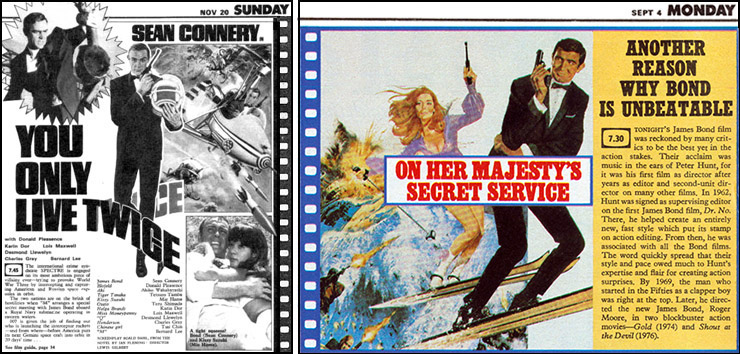 |
|||||||||||||||||||||||||||||||||||||||||||||||||||||||||||||||||||||||||||||||||||||||||||||||||||||||||||||||||||||||||||||||||||||||||||||||||
|
|||||||||||||||||||||||||||||||||||||||||||||||||||||||||||||||||||||||||||||||||||||||||||||||||||||||||||||||||||||||||||||||||||||||||||||||||
|
|||||||||||||||||||||||||||||||||||||||||||||||||||||||||||||||||||||||||||||||||||||||||||||||||||||||||||||||||||||||||||||||||||||||||||||||||
|
Goldfinger had been shown for a second time on Sunday March 12, 1978, and achieved the highest audience regardless of channel for the whole of the month, with a staggering 22.5-million viewers. ITV then chose to screen Goldfinger again on Christmas Day 1979, but this time at 3.15pm directly after The Queen's Christmas message thereby holding onto a captive audience. Although trimmed to suit its afternoon slot [and shown opposite The Beatles’ A Hard Day's Night (1964) on BBC2], Goldfinger attracted a respectable audience of 14.5-million viewers for its third TV outing. |
|||||||||||||||||||||||||||||||||||||||||||||||||||||||||||||||||||||||||||||||||||||||||||||||||||||||||||||||||||||||||||||||||||||||||||||||||
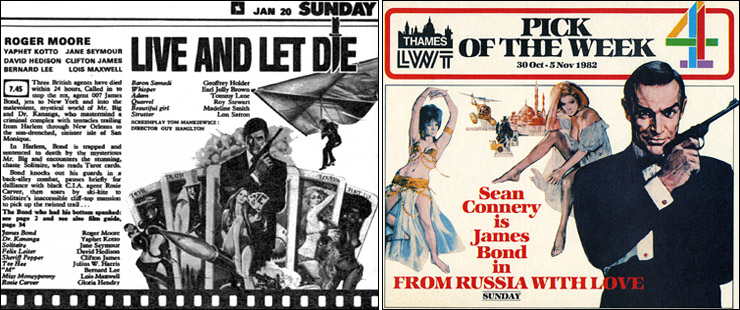 |
|||||||||||||||||||||||||||||||||||||||||||||||||||||||||||||||||||||||||||||||||||||||||||||||||||||||||||||||||||||||||||||||||||||||||||||||||
|
Four weeks later Live And Let Die premiered on the ITV network at 7.45pm on Sunday January 20, 1980, and broke all records with an audience of 23.5-million viewers. The Man With The Golden Gun then had its ITV premiere on Christmas Day 1980, six years after its theatrical debut. Screened at 6.10pm, Roger Moore's second James Bond film could not compete with the BBC's line-up of popular entertainment programmes, and only achieved the number nine position in that week's overall ratings, being watched by 15.3-million viewers. A second transmission on March 6, 1983, showed that a non-Christmas screening was even more popular, attracting 15.7-million viewers, and only beaten as the most popular ITV broadcast that month by the long-running soap opera Coronation Street. |
|||||||||||||||||||||||||||||||||||||||||||||||||||||||||||||||||||||||||||||||||||||||||||||||||||||||||||||||||||||||||||||||||||||||||||||||||
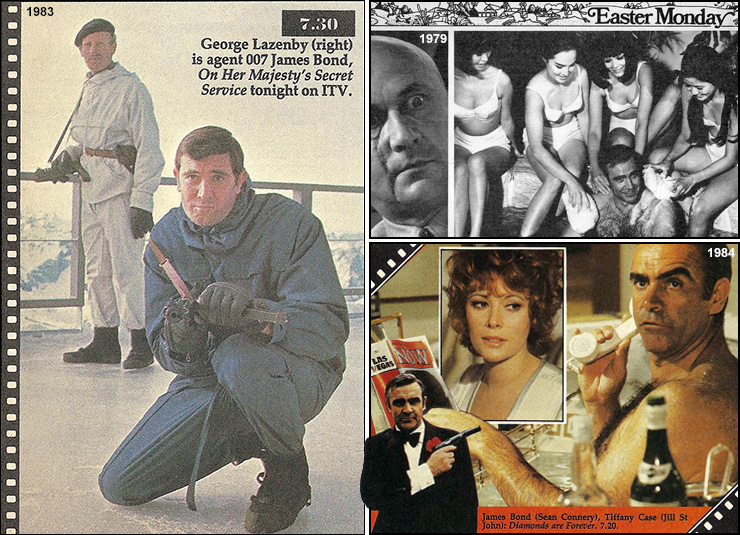 |
|||||||||||||||||||||||||||||||||||||||||||||||||||||||||||||||||||||||||||||||||||||||||||||||||||||||||||||||||||||||||||||||||||||||||||||||||
|
With Thunderball not fully networked on all ITV channels when first shown in 1977, it was not until its fourth broadcast on Monday, January 2, 1984, (almost six years since its last screening) that the film reached the number one spot in that week's ratings, with an audience of 16.65-million - beating it nearest rival Coronation Street by over one-million viewers. It is perhaps no surprise that ITV chose to screen Sean Connery's fourth James Bond film at the same time his comeback Never Say Never Again was in cinemas across the UK. Interest in Ian Fleming's controversial 1961 novel was clearly at a peak, and had even prompted EON Productions to re-issue Thunderball exclusively at London's Empire 1 cinema in Leicester Square, on a triple-bill with For Your Eyes Only and Octopussy for two weeks from Friday December 9, 1983, to coincide with the UK opening of Never Say Never Again 100-yards away at the Warner West End Theatre the following week. |
|||||||||||||||||||||||||||||||||||||||||||||||||||||||||||||||||||||||||||||||||||||||||||||||||||||||||||||||||||||||||||||||||||||||||||||||||
|
|||||||||||||||||||||||||||||||||||||||||||||||||||||||||||||||||||||||||||||||||||||||||||||||||||||||||||||||||||||||||||||||||||||||||||||||||
|
From Russia With Love did not receive its third ITV screening until Sunday, October 31, 1982 [the same week that saw the launch of Channel 4, and a week after the ITV television premiere of the blockbusting Star Wars (1977)], so had been largely unseen for six years. From Russia With Love had been released on VHS (along with Goldfinger) in June of 1982, and were the first two James Bond films available to rent on video in the UK. It therefore came as no surprise that the ITV broadcast attracted a very large audience of almost 14-million viewers, only beaten in the weekly ratings by the soap opera Coronation Street, and the popular surprise biography show This Is Your Life [featuring much-loved English actress Diana Dors (1931-1984)]. |
|||||||||||||||||||||||||||||||||||||||||||||||||||||||||||||||||||||||||||||||||||||||||||||||||||||||||||||||||||||||||||||||||||||||||||||||||
|
|||||||||||||||||||||||||||||||||||||||||||||||||||||||||||||||||||||||||||||||||||||||||||||||||||||||||||||||||||||||||||||||||||||||||||||||||
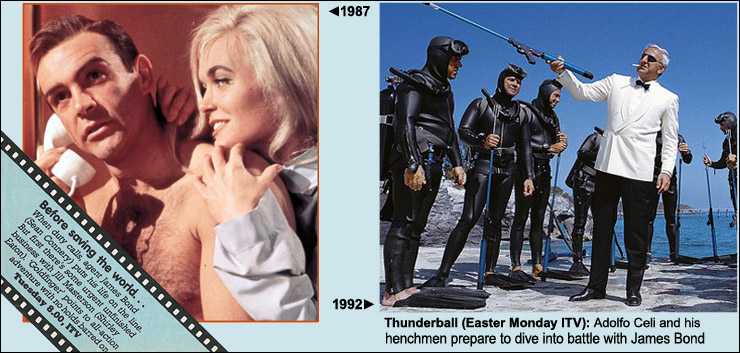 |
|||||||||||||||||||||||||||||||||||||||||||||||||||||||||||||||||||||||||||||||||||||||||||||||||||||||||||||||||||||||||||||||||||||||||||||||||
|
Although the James Bond films were massively popular when first shown on the ITV network, and still attracted a huge audience on later broadcasts; they failed to top the ratings when screened on Christmas Day, or on a Saturday evening, when they had far more competition from other programmes. The James Bond series still remains a major part of ITV's scheduling, with hardly a week going by without one or more of the films being shown on the network's channels, although viewing figures are nowhere near what they were before the series became widely available on home media. Screenings nowadays are no longer the television event they used to be, when almost half the nation tuned in, and probably now viewed more as background entertainment to be dipped into while channel-hopping. With the shift away from feature films as the must-see shared experience; they have been replaced by talent contests and reality television, and no longer the “Did you see..?” talking point in so many workplaces and school playgrounds on the morning following the broadcast. |
|||||||||||||||||||||||||||||||||||||||||||||||||||||||||||||||||||||||||||||||||||||||||||||||||||||||||||||||||||||||||||||||||||||||||||||||||
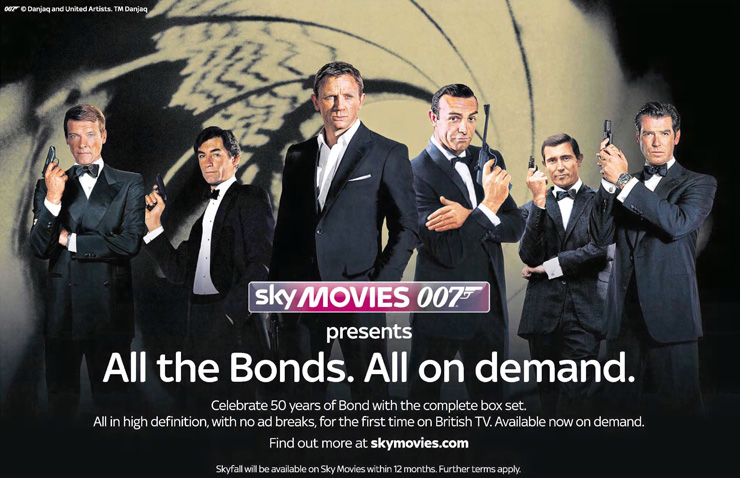 |
|||||||||||||||||||||||||||||||||||||||||||||||||||||||||||||||||||||||||||||||||||||||||||||||||||||||||||||||||||||||||||||||||||||||||||||||||
|
“All the
Bonds...” |
|||||||||||||||||||||||||||||||||||||||||||||||||||||||||||||||||||||||||||||||||||||||||||||||||||||||||||||||||||||||||||||||||||||||||||||||||
|
|||||||||||||||||||||||||||||||||||||||||||||||||||||||||||||||||||||||||||||||||||||||||||||||||||||||||||||||||||||||||||||||||||||||||||||||||
|
No Time To Die (2021) had its UK terrestrial television premiere on ITV at 8.00pm on New Year's Day 2023, which marked the narrowest big to small screen window of the series so far. The premiere on the UK's free-to-air commercial network came just 460 days after its much-delayed big screen debut at London's Royal Albert Hall on September 28, 2021. Predictably, the ITV screening was cut to suit the requirements of its pre-watershed timeslot. The ITV premiere attracted a live audience of 2.56-million viewers. |
|||||||||||||||||||||||||||||||||||||||||||||||||||||||||||||||||||||||||||||||||||||||||||||||||||||||||||||||||||||||||||||||||||||||||||||||||
|
|||||||||||||||||||||||||||||||||||||||||||||||||||||||||||||||||||||||||||||||||||||||||||||||||||||||||||||||||||||||||||||||||||||||||||||||||
|
|
|||||||||||||||||||||||||||||||||||||||||||||||||||||||||||||||||||||||||||||||||||||||||||||||||||||||||||||||||||||||||||||||||||||||||||||||||